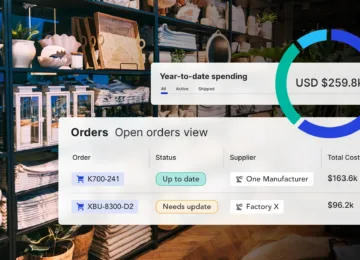Ensuring your supply chain operates at peak performance is no small feat. Any inefficiency or disruption can have cascading effects, leading to increased costs, delays, and customer dissatisfaction. This is why having a firm grip on your supply chain’s performance is vital.
Supply chain KPIs work as a compass that guides your business through this complex world. They enable you to not only measure the performance of your supply chain but also empower you to make informed decisions, identify areas for improvement, and achieve your strategic goals.
But what KPIs tell the most accurate story of your supply chain’s performance? In this blog, we share our top 10 supply chain KPIs for achieving peak efficiency. Let’s dive right into what they are and how you can use them to optimize your supply chain.
1. Supplier Engagement Rate
Suppliers aren’t just material or product sources. They’re key partners in your success. Supplier engagement rate, therefore, is a critical supply chain KPI that reflects the strength of these partnerships and your ability to work together seamlessly.
Supplier engagement rate measures the level of collaboration and communication with your suppliers. It encompasses several metrics, including responsiveness, issue resolution speed, and the quality and consistency of their products.
A high supplier engagement rate indicates smoother operations and better reliability. On the flip side, a low engagement rate can be an early warning sign of potential issues, such as communication breakdowns, quality problems, or supply disruptions.
How to Improve Supplier Engagement Rate: To improve your supplier engagement rate, it’s essential to establish clear communication channels, set expectations, and regularly assess supplier performance.
This is a strategy that’s worked for luxury bedding brand Brooklinen, who has achieved an impressive 95% supplier engagement rate since onboarding Anvyl’s intelligent PO management platform alongside its Netsuite ERP. It uses our integrations to boost two-way communication, improve collaboration, and enhance supplier alignment.
2. Order Delays
Order delays represent the percentage of purchase orders that experience delays in processing, manufacturing, or shipping. It’s a critical supply chain KPI in the supply chain, as it directly impacts your ability to meet customer expectations and influences the overall efficiency and effectiveness of your operations.
Naturally, you want your number of delayed orders to be as low as possible. However, achieving a perfect on-time performance isn’t always possible, given the number of variables at play. This KPI is highly effective at highlighting areas where operational improvements are needed, however. Tracking order delays provides valuable insights into supply chain trends and patterns, which can help you make informed decisions about inventory management, resource allocation, and supplier performance. It also assists in setting realistic delivery timeframes that can be consistently met.
How to Reduce Order Delays: Foster open and transparent communication with all stakeholders, including suppliers, production teams, and logistics partners. Clear communication channels help identify issues early and find quick solutions. You should also focus on improving the quality of your supplier relationships since reliable suppliers are more likely to deliver on time and with consistent quality. Maintaining close supplier relationships allows you to collaborate on demand forecasting, quality standards, and contingency plans, all of which contribute to a smooth PO process.
Investing in supply chain management software also helps to reduce order delays. Supply chain platforms help you track and manage orders, inventory, and production schedules more efficiently. Additionally, systems armed with artificial intelligence algorithms and machine learning can actually help you identify delays before they happen, eliminating your need to scramble and allowing you to make cost-saving adjustments.
Native, the maker of natural personal care products, decreased order delays by 35% after integrating Anvyl into its tech stack. Crucial was its ability to scale real-time collaboration, automate critical tasks, and empower its team with deeper insights to make smarter, brand-driven decisions, faster.
3. On-time Shipments
On-time shipments track the percentage of orders or shipments that leave your supplier’s facility on time as promised. This KPI differs from order delays, which can happen even after a shipment leaves your supplier’s warehouse on-time, placing someone other than your supplier, like your shipping partner, at fault.
High on-time shipments indicate that a supplier is consistently meeting or exceeding expectations by delivering products or orders when promised. This, in turn, influences your ability to meet the expectations of your own customers and maintain a reliable reputation.
How On-time Shipments Impact Performance: On-time shipments are also closely tied to efficient inventory management. When orders are consistently delivered on time, it reduces the need for excessive safety stock and expedites order processing, leading to cost savings and streamlined operations. It also reduces the need for expediting shipments, lessens overtime for labor, and lowers warehousing costs, resulting in significant cost savings.
Order volume tracks the total number of orders your business receives within a specified timeframe. This KPI is a barometer of your customers’ demand and can provide valuable insights into your supply chain and production needs. It’s typically used as an indicator of growth, since a steady growth in orders usually means a healthy and expanding customer base.
4. Order Volume
How to Understand Order Volume: Tracking order volume is much more nuanced than you might think. It tells a much deeper story about the health of your supply chain than just customer demand. To fully leverage it for peak performance, you must use it to understand the following:
- Seasonal and Trend Analysis: Tracking order volume over time helps identify seasonal and trend patterns. For example, you may notice an uptick in orders during the holiday season or specific promotions. Recognizing these patterns enables you to prepare your supply chain in advance, ensuring you can meet increased demand without delays.
- Production Optimization: You can use order volume data to optimize your production schedules. A consistent or growing order volume might justify investing in additional equipment or automation to meet demand while minimizing production delays.
- Inventory Management: Maintaining the right level of inventory is essential. Order volume helps you balance having enough stock to meet demand without overstocking, which can lead to storage costs and obsolescence.
- Benchmarking and Goal Setting: You can use historical order volume data to set performance goals and benchmarks. Consistently meeting or exceeding these benchmarks is a sign of a well-managed and adaptable supply chain.
5. Purchase Order (PO) Revisions
Purchase Order (PO) revisions offer insights into how often and why purchase orders need revisions and how effectively your organization handles these changes. PO revisions encompass any modifications, alterations, or updates made to purchase orders after their initial creation. These revisions can include quantity changes, delivery dates, pricing, or specifications.
While some revisions are normal, and necessary to accommodate changing conditions in the supply chain, an excessively high number of revisions should raise concerns. It indicates a need to review and improve your order planning, communication processes, and supplier relationships to reduce the need for revisions and ensure a more efficient and cost-effective supply chain.
How to Decrease PO Revisions: Leveraging technology can be highly effective in reducing PO revisions within your supply chain. Intelligent PO management platforms, like Anvyl’s, enable you to create standardized, error-free purchase orders, reducing the likelihood of revisions due to incorrect or missing information. Their automated capabilities streamline and accelerate the entire procurement process, leading to fewer discrepancies and costly rework.
Luxury beauty brand, Fig.1, is a great example of a brand that’s successfully reduced its PO revisions using technology. As rising customer demand pushed the DTC retailer to scale its supply chain, a reliable PO management strategy was paramount for success. With the end-to-end visibility granted by Anvyl and its ability to form stronger supplier relationships, Fig.1 reduced PO changes by 53% between 2021 and 2022.
6. Inventory Turnover
Inventory Turnover is a critical KPI in supply chain and inventory management. It quantifies the efficiency of your inventory management processes and reflects how quickly you are selling the inventory you hold. The formula for calculating Inventory Turnover is as follows:
Inventory Turnover = Cost of Goods Sold (COGS) / Average Inventory Value
Understanding Inventory Turnover’s Significance: Inventory turnover measures how efficiently your organization manages inventory. A higher turnover rate indicates that you are selling inventory quickly, reducing the carrying costs of holding excess stock.
A lower inventory turnover rate suggests the opposite, likely incurring higher holding costs and potential overstock issues. It can also hint at a failing product or market strategy, inaccurate demand forecasting, and an increased risk of inventory depreciation. It’s important to consider seasonality, however. A lower turnover rate during off-peak seasons may be acceptable as long as it aligns with your business strategy.
7. Lead Time
Lead time quantifies the time it takes for an order to be fulfilled from the moment it’s placed. This supply chain KPI is integral for assessing the efficiency of your supply chain and has far-reaching implications on things like customer satisfaction, competitive advantage, inventory management, demand forecasting, cash flow, and supplier relations. Short lead times are crucial to growth and success. They impact your ability to get to market, meet customer demand, and achieve leaner operations.
How to Reduce Lead Time: Anvyl recently published a blog detailing its top 10 tips for reducing lead time. Among our favorite strategies are:
- Prioritize domestic suppliers
- Increase order frequency
- Include suppliers in your demand forecasting process
- Refine your supply chain management strategy
- Eliminate unreliable suppliers from your supply chain
Click here to learn more ways to reduce lead time.
8. Order Accuracy
Order accuracy analyzes the precision and effectiveness of your purchase order processes. It measures how purchase orders are created and fulfilled correctly and without errors. This KPI ensures supplier relations, operational efficiency, and overall supply chain performance.
How to Optimize Order Accuracy: Supply chain teams should always strive for high levels of purchase order accuracy. Let’s take a look at what this means for your brand:
- Supplier Satisfaction: Accurate purchase order fulfillment is a crucial factor in maintaining positive supplier relations. When suppliers receive clear and precise purchase orders that align with their expectations, it enhances trust in your business.
- Error Reduction: The goal of this KPI is to minimize errors in the purchase order process, such as incorrect product descriptions, quantities, or pricing. Error reduction is a primary objective of supply chain optimization efforts.
- Supplier Performance: High order accuracy encourages better supplier performance and adherence to agreed-upon terms and conditions. Suppliers are more likely to meet delivery timelines and provide quality products.
- Cost Savings: Fewer errors also mean less time and labor spent on resolving issues, reordering, and re-negotiating contracts.
- Inventory Management: Accurate orders help maintain the proper stock levels, reducing overstock or understock situations.
- Data-driven Decision Making: Order data can be analyzed to identify patterns and root causes of errors. This analysis informs data-driven decision-making to implement improvements in processes, training, or technology.
9. Transportation Cost Per Unit
This KPI evaluates the efficiency and cost-effectiveness of your transportation operations. It assesses the cost incurred to transport each unit of product, goods, or materials, reflecting the performance and financial health of your supply chain.
Lower transportation costs per unit reflect effective transportation strategies, better resource allocation, and streamlined operations. Higher costs indicate issues in your supply chain and transportation strategy, highlighting potential inefficiencies with your freight methods, carrier selection, shipment volumes, or route planning.
What Your Transportation Cost Per Unit Tells You About Your Supply Chain: In addition to uncovering the cost-effectiveness of your supply chain, this KPI is fundamental for several reasons. Here’s a breakdown of some other ways it contributes to your supply chain’s performance:
- Competitive Advantage: A low Transportation Cost per Unit can provide a competitive advantage in the market. It allows you to offer more competitive prices, reduce overall costs, and gain market share.
- Cost Reduction Opportunities: By monitoring this KPI, you can identify areas for potential cost reduction, such as optimizing shipping routes, consolidating shipments, and negotiating better carrier contracts.
- Customer Pricing Strategies: Transportation Cost per Unit data helps inform pricing strategies. It allows you to set pricing that covers transportation costs while remaining attractive to customers.
- Carbon Footprint: Optimizing transportation can have environmental benefits. A more efficient transportation system typically reduces fuel consumption and emissions, contributing to sustainability goals.
- Risk Mitigation: Efficient transportation can reduce the risk of disruptions in the supply chain. Diverse transportation options and optimized routes can minimize the impact of unforeseen events.
10. Supplier Performance Score
A Supplier Performance Score, often referred to as a Supplier Scorecard or Supplier Rating, is a vital tool in supply chain management that quantifies and assesses the performance and reliability of your suppliers. This score provides a comprehensive view of a supplier’s ability to meet contractual obligations, deliver quality products or services, and maintain a productive and cooperative relationship with your organization.
Several metrics contribute to a supplier’s performance score. These include on-time delivery rates, responsiveness, product quality, lead time accuracy, and problem resolution. In today’s ultra-competitive market, working with high-scoring suppliers is imperative for retailers as they contribute to your ability to meet customer demands effectively.
How to Measure and Monitor Supplier Performance: Regularly measuring and monitoring supplier performance using such a scorecard is essential for achieving efficient, reliable, and sustainable supply chain operations. You can accurately measure your supplier’s performance over time using Anvyl’s intelligent PO management platform. Our supplier scorecards track key performance indicators such as responsiveness and on-time delivery rates, highlighting where suppliers excel and areas for improvement.
Our technology also empowers you to improve your supplier relationships, providing a centralized and streamlined communication platform that sets you and your suppliers up for success.
Ready to achieve peak supply chain performance?
Contact our team today to learn more about how our intelligent PO management platform is helping the world’s fastest-growing DTC retailers simplify and centralize their supply chain!



